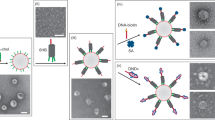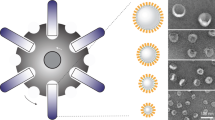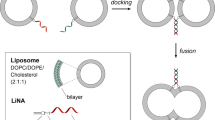Abstract
The liposome dialyzer is a small-volume equilibrium dialysis device, built from commercially available materials, that is designed for the rapid exchange of small volumes of an extraliposomal reagent pool against a liposome preparation. The dialyzer is prepared by modification of commercially available dialysis cartridges (Slide-A-Lyzer cassettes), and it consists of a reactor with two 300-μl chambers and a 1.56-cm2 dialysis surface area. The dialyzer is prepared in three stages: (i) disassembling the dialysis cartridges to obtain the required parts, (ii) assembling the dialyzer and (iii) sealing the dialyzer with epoxy. Preparation of the dialyzer takes ∼1.5 h, not including overnight epoxy curing. Each round of dialysis takes 1–24 h, depending on the analyte and membrane used. We previously used the dialyzer for small-volume non-enzymatic RNA synthesis reactions inside fatty acid vesicles. In this protocol, we demonstrate other applications, including removal of unencapsulated calcein from vesicles, remote loading and vesicle microscopy.
This is a preview of subscription content, access via your institution
Access options
Subscribe to this journal
Receive 12 print issues and online access
$259.00 per year
only $21.58 per issue
Buy this article
- Purchase on Springer Link
- Instant access to full article PDF
Prices may be subject to local taxes which are calculated during checkout





Similar content being viewed by others
References
Adamala, K. & Szostak, J.W. Nonenzymatic template-directed RNA synthesis inside model protocells. Science 342, 1098–1100 (2013).
Deck, C., Jauker, M. & Richert, C. Efficient enzyme-free copying of all four nucleobases templated by immobilized RNA. Nat. Chem. 3, 603–608 (2011).
Zhu, T.F. & Szostak, J.W. Coupled growth and division of model protocell membranes. J. Am. Chem. Soc. 131, 5705–5713 (2009).
Zhu, T.F. & Szostak, J.W. Preparation of large monodisperse vesicles. PLoS ONE 4, e5009 (2009).
Tsumoto, K., Nomura, S.-i.M., Nakatani, Y. & Yoshikawa, K. Giant liposome as a biochemical reactor: transcription of DNA and transportation by laser tweezers. Langmuir 17, 7225–7228 (2001).
Murtas, G., Kuruma, Y., Bianchini, P., Diaspro, A. & Luisi, P.L. Protein synthesis in liposomes with a minimal set of enzymes. Biochem. Biophys. Res. Commun. 363, 12–17 (2007).
Nishikawa, T., Sunami, T., Matsuura, T. & Yomo, T. Directed evolution of proteins through in vitro protein synthesis in liposomes. J. Nucleic Acids 2012, 923214 (2012).
Lentini, R. et al. Integrating artificial with natural cells to translate chemical messages that direct E. coli behaviour. Nat. Commun. 5, 4012 (2014).
Fujii, S. et al. Liposome display for in vitro selection and evolution of membrane proteins. Nat. Protoc. 9, 1578–1591 (2014).
Tan, M.L., Choong, P.F. & Dass, C.R. Recent developments in liposomes, microparticles and nanoparticles for protein and peptide drug delivery. Peptides 31, 184–193 (2010).
Allen, T.M. & Cullis, P.R. Liposomal drug delivery systems: from concept to clinical applications. Adv. Drug Deliv. Rev. 65, 36–48 (2013).
Malam, Y., Loizidou, M. & Seifalian, A.M. Liposomes and nanoparticles: nanosized vehicles for drug delivery in cancer. Trends Pharmacol. Sci. 30, 592–599 (2009).
Gabizon, A. et al. Prolonged circulation time and enhanced accumulation in malignant exudates of doxorubicin encapsulated in polyethylene-glycol coated liposomes. Cancer Res. 54, 987–992 (1994).
Haran, G., Cohen, R., Bar, L.K. & Barenholz, Y. Transmembrane ammonium sulfate gradients in liposomes produce efficient and stable entrapment of amphipathic weak bases. Biochim. Biophys. Acta 1151, 201–215 (1993).
Barenholz, Y. Doxil(R)—the first FDA-approved nano-drug: lessons learned. J. Control. Release 160, 117–134 (2012).
Hwang, S.H., Maitani, Y., Qi, X.R., Takayama, K. & Nagai, T. Remote loading of diclofenac, insulin and fluorescein isothiocyanate labeled insulin into liposomes by pH and acetate gradient methods. Int. J. Pharm. 179, 85–95 (1999).
Stano, P. et al. Novel camptothecin analogue (gimatecan)-containing liposomes prepared by the ethanol injection method. J. Liposome Res. 14, 87–109 (2004).
Stano, P. & Luisi, P.L. Achievements and open questions in the self-reproduction of vesicles and synthetic minimal cells. Chem. Commun. (Camb.) 46, 3639–3653 (2010).
Joyce, G.F., Inoue, T. & Orgel, L.E. Non-enzymatic template-directed synthesis on RNA random copolymers. Poly(C, U) templates. J. Mol. Biol. 176, 279–306 (1984).
Kamat, N.P. et al. A generalized system for photo-responsive membrane rupture in polymersomes. Adv. Funct. Mater. 20, 2588–2596 (2010).
Adamala, K. & Szostak, J.W. Competition between model protocells driven by an encapsulated catalyst. Nat. Chem. 5, 495–501 (2013).
Acknowledgements
This work was supported in part by The National Aeronautics and Space Administration (NASA) Exobiology grant NNX07AJ09G to J.W.S. and in part by a grant (290363) from the Simons Foundation to J.W.S. A.E.E. and N.P.K. were supported by appointments to the NASA Postdoctoral Program, administered by Oak Ridge Associated Universities through a contract with NASA. A.E.E. was supported by a Tosteson Fellowship from the Massachusetts General Hospital Executive Committee on Research. J.W.S. is an Investigator of the Howard Hughes Medical Institute.
Author information
Authors and Affiliations
Contributions
K.A., A.E.E., N.P.K. and L.J. performed the experiments. K.A., A.E.E., N.P.K., L.J. and J.W.S. wrote the manuscript. J.W.S. supervised the research.
Corresponding author
Integrated supplementary information
Supplementary Figure 1 Disassembled Slide-A-Lyzers, ready for assembly.
Two gaskets from two Slide-A-Lyzer units and both parts of the plastic frame of one of the Slide-A-Lyzers are used. Note that one of the gaskets (right) still has one dialysis membrane attached.
Supplementary Figure 2 PCR film to create clear sample viewing windows
A: Two pieces of PCR film, with the back paper still attached, cut out in the shape and size big enough to cover the openings in the plastic frame. B: The cut piece of PCR film is applied to the inside of one half of the plastic frame, and pressed into grooves of the inside of the frame with a pipette tip. C: The PCR film applied to the inside of one half of the plastic frame. The film’s sticky side points to the outside of the dialyzer, and the film fully covers the opening in the half-frame.
Supplementary Figure 3 Insertion of needle into gasket.
A: silicone gasket is pre-punctured with a beveled needle (green) and the blunt needle (blue) is inserted into the opening made with the beveled needle. B: The blunt needle is positioned so that the blunt end of the needle goes all the way through the gasket, but it does not stick out more than half a millimeter inside the gasket. C: A silicone gasket is aligned to cover the window on one half of the plastic frame. The second silicone gasket is aligned on top of the first one, with the single remaining dialysis membrane between the gaskets. D: Side view of the one half of the plastic frame with both silicone gaskets aligned on it. One of the two blunt needles going through the gaskets is visible.
Supplementary Figure 4 Assembled dialyzer before application of epoxy.
A: Both halves of the plastic frame assembled with two silicone gaskets, two needles, and one dialysis membrane, ready to be glued. B: The dialyzer assembly, placed in the bar clamp for gluing. The bar clamps are wrapped in plastic to avoid contamination from the epoxy (and avoid the dialyzer being permanently glued to the clamp if some epoxy leaks out). C: The dialyzer assembly in the bar clamp, with silicone gaskets properly aligned.
Supplementary Figure 5 Application of epoxy to dialyzer.
Epoxy, applied to all sides of the dialyzer assembly and the outer diameter of the blunt needles.
Supplementary Figure 6 Completed dialyzer.
A: Completed dialyzer assembly, removed from the bar clamp after the epoxy has fully cured (24h) and with needles capped.
B: Close-up of the finished dialyzer assembly, with needles going through the silicone gaskets and into the dialysis chambers.
Supplementary Figure 7 Dissassembled Slide-A-Lyzer G2.
The disassembled G2 dialyzer cassette.
The assembly of the G2 based dialyzer is analogous to the process described for the standard slide-a-lyzer cassette; the few notable differences are shown in Supplementary Figures 8-9.
Supplementary Figure 8 G2 dialyzer in bar clamp with epoxy applied.
A: Side view of the G2 dialyzer in the vice clamp, showing parallel alignment of the two sample port plugs aligned on top of the assembly. B: Alignment of G2 dialyzer in bar clamp.
Supplementary Figure 9 Completed G2 dialyzer.
A: The top view of the assembled G2 dialyzer, showing the sample ports. B: Front view of the fully assembled G2 dialyzer, showing the tip of the sample port plug sticking into the dialysis chamber.
Supplementary information
Supplementary Text and Figures
Supplementary Figures 1–9 (PDF 778 kb)
Rights and permissions
About this article
Cite this article
Adamala, K., Engelhart, A., Kamat, N. et al. Construction of a liposome dialyzer for the preparation of high-value, small-volume liposome formulations. Nat Protoc 10, 927–938 (2015). https://doi.org/10.1038/nprot.2015.054
Published:
Issue Date:
DOI: https://doi.org/10.1038/nprot.2015.054
This article is cited by
-
Engineering genetic circuit interactions within and between synthetic minimal cells
Nature Chemistry (2017)
-
Recognizing single phospholipid vesicle collisions on carbon fiber nanoelectrode
Science China Chemistry (2017)
Comments
By submitting a comment you agree to abide by our Terms and Community Guidelines. If you find something abusive or that does not comply with our terms or guidelines please flag it as inappropriate.



